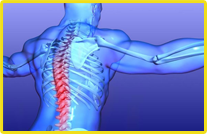
In 1874, Andrew Taylor, M.D., became dissatisfied with the existing medical fields and the use of dangerous drugs and compounds for "curing" illnesses. Taylor believed that the body has an inherent ability to heal itself if its systems were in balance.
Taylor felt that a doctor could promote self-healing by minimizing obstructions to blood and lymph flow, and keeping the musculoskeletal system in alignment. He developed techniques to manipulate soft tissue and bone. His work was instrumental in laying the groundwork for osteopathy medicine.
Dr. William Sutherland enrolled in an unorthodox medical school in the late 1890s. Later, as an osteopath, he was instrumental in advancing and changing the concepts of "self-healing."
Dr. Sutherland's theory that the central nervous system was in "constant rhythmic motion" was later validated by advanced diagnostic equipment. This constant rhythmic motion was found to be essential for life and well being. He believed that a dysfunction in one area of the body would lead to a compromise of the entire structure of the body.
In "Five Components of the Primary Respiratory Mechanism," Dr. Sutherland summarized the working principles of osteopathy:

These principles are the basis of the treatment protocols of osteopathic medicine.
Osteopathic medicine is similar to traditional, or allopathic, medicine but it places a much greater emphasis on the role of normal body mechanics and the musculoskeletal system. One of the principles of osteopathic medicine is that the patients' illness and traumas are stored within the structure of their bodies.
The osteopath, like a chiropractor, is trained to palpate (touch) the body to detect tissue texture, flow of fluids, and motion of joints, and to seek out impairments caused by traumatic injuries and chronic or acute illnesses. The objective of the osteopathic physician is to restore the body to its normal or full function by applying a precise amount of force to promote movement of fluids, (a rhythmic flow of cerebrospinal fluid in the brain and spinal cord), decompress joints and bones, and increase tissue function.
Like chiropractors in their philosophy and approach, osteopaths use their hands to diagnosis and treat, see the body as a single functional unit, and value the wisdom of the body's ability to heal itself.
The body is a unit where dysfunction in one areas can affect another area. For example, a disc problem in the neck can pull the legs and affect the way we walk. Treatment for the legs can significantly reduce the neck pain.
Osteopaths treat birth and pediatric problems such as palsy, colic, and learning disorders. They also treat neck and back problems such a headaches, sciatica, overuse syndrome and trauma.
Among the systemic problems successfully treated by osteopaths are nerve problems, digestive disorders, infections, such as sinusitis and colds, chronic ear infection, respiratory problems, such as asthma and allergies.